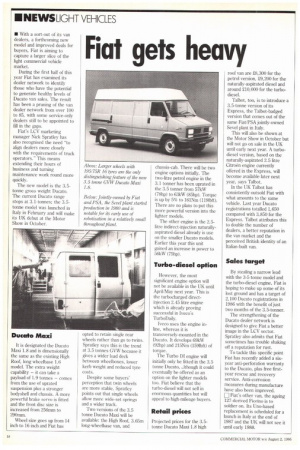Fiat gets heavy
Page 20

If you've noticed an error in this article please click here to report it so we can fix it.
• With a sort-out of its van dealers, a forthcoming new model and improved deals for buyers, Fiat is aiming to capture a larger slice of the light commercial vehicle market.
During the first half of this year Fiat has examined its dealer network to identify those who have the potential to generate healthy levels of Ducato van sales. The result has been a pruning of the van dealer network from over 100 to 85, with some service-only dealers still to be appointed to fill in the gaps.
Fiat's LCV marketing manager Nick Spratley has also recognised the need "to align dealers more closely with the requirements of truck operators." This means extending their hours of business and turning maintenance work round more quickly.
The new model is the 3.5tonne gross weight Ducato. The current Ducato range stops at 3. 1-tonnes; the 3.5tonne model was launched in Italy in February and will make its UK debut at the Motor Show in October.
Ducato Maxi
It is designated the Ducato Maxi 1.8 and is dimensionally the same as the existing High Roof, long wheelbase 1.6 model. The extra weight capability — it can take a payload of 1.9 tonnes — comes from the use of uprated suspension plus a stronger bodyshell and chassis. A more powerful brake servo is fitted and the front disc size is increased from 256nun to 290mm.
Wheel size goes up from 14 inch to 16 inch and Fiat has opted to retain single rear wheels rather than go to twins. Spratley says this is the trend at 3.5 tonnes GVW because it gives a wider load deck between wheelboxes, lower kerb weight and reduced tyre costs.
Despite some buyers' perception that twin wheels are more stable, Spratley points out that single wheels allow more wide-set springs and a wider track.
Two versions of the 3.5 tonne Ducato Maxi will be available: the High Roof, 3.65m long-wheelbase van, and chassis-cab. There will be two engine options initially. The two-litre petrol engine in the 3.1 tonner has been uprated in the 3.5 tonner from 57kW (78hp) to 63kW (85hp). Torque is up by 5% to 161Nrn (1191bft). There are no plans to put this more powerful version into the lighter models.
The other engine is the 2.5litre indirect-injection naturallyaspirated diesel already is use on the smaller Ducato models. Earlier this year this unit gained an increase in power to 56kW (75hp).
Turbo-diesel option
However, the most significant engine option will not be available in the UK until April/May next year. This is the turbocharged directinjection 2.45 litre engine which is already proving successful in Iveco's TurboDaily.
Iveco uses the engine inline, whereas it is transversely-mounted in the Ducato. It develops 69kW (92hp) and 215Nm (1591bft) of torque.
'rhe Turbo DI engine will initially only be fitted in the 3.5 tonne Ducato, Jthough it could eventually be offered as an option on the lighter models too. Fiat believe that the turbo-diesel will not sell in enormous quantities but will appeal to high-mileage buyers.
Retail prices
Projected prices for the 3.5tonne Ducato Maxi 1.8 high roof van are 28,300 for the petrol version, £9,200 for the naturally-aspirated diesel and around £10,000 for the turbodiesel.
Talbot, too, is to introduce a 3.5-tonne version of its Express, the Talbot-badged version that comes out of the same Fiat/PSA jointly-owned Sevel plant in Italy.
This will also be shown at the Motor Show in October but will not go on sale in the UK until early next year. A turbodiesel version, based on the naturally-aspirated 2.5 litre Citroen engine currently offered in the Express, will become available later next year, says Talbot.
In the UK Talbot has consistently outsold Fiat with what amounts to the same vehicle. Last year Ducato registrations totalled 1,650 compared with 3,850 for the Express. Talbot attributes this to double the number of dealers, a better reputation in the van market and the perceived British identity of an Italian-built van.
Sales target
By stealing a narrow lead with the 3-5 tonne model and the turbo-diesel engine, Fiat is hoping to make up some of its lost ground and has a target of 2,100 Ducato registrations in 1986 with the benefit of just two months of the 3.5-tonner.
The strengthening of the Ducato dealer network is designed to give Fiat a better image in the LCV sector. Spratley also admits that Fiat sometimes has trouble shaking off a reputation for rust.
To tackle this specific point Fiat has recently added a sixyear anti-perforation warranty to the Ducato, plus free firstyear rescue and recovery service. Anti-corrosion measures during manufacture have also been improved.
Fiat's other van, the ageing 127-derived Florin° is to soldier on. Its Uno-based replacement is scheduled for a launch in Italy at the end of 1987 and the UK will not see it until early 1988.












































































